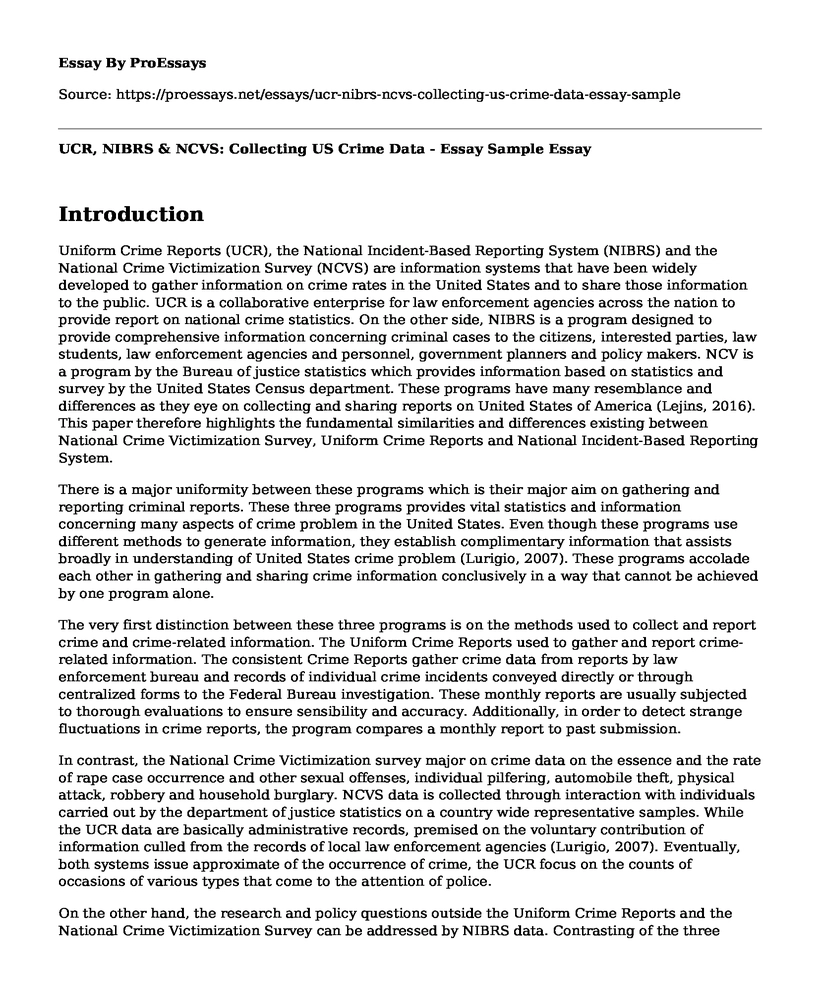Introduction
Uniform Crime Reports (UCR), the National Incident-Based Reporting System (NIBRS) and the National Crime Victimization Survey (NCVS) are information systems that have been widely developed to gather information on crime rates in the United States and to share those information to the public. UCR is a collaborative enterprise for law enforcement agencies across the nation to provide report on national crime statistics. On the other side, NIBRS is a program designed to provide comprehensive information concerning criminal cases to the citizens, interested parties, law students, law enforcement agencies and personnel, government planners and policy makers. NCV is a program by the Bureau of justice statistics which provides information based on statistics and survey by the United States Census department. These programs have many resemblance and differences as they eye on collecting and sharing reports on United States of America (Lejins, 2016). This paper therefore highlights the fundamental similarities and differences existing between National Crime Victimization Survey, Uniform Crime Reports and National Incident-Based Reporting System.
There is a major uniformity between these programs which is their major aim on gathering and reporting criminal reports. These three programs provides vital statistics and information concerning many aspects of crime problem in the United States. Even though these programs use different methods to generate information, they establish complimentary information that assists broadly in understanding of United States crime problem (Lurigio, 2007). These programs accolade each other in gathering and sharing crime information conclusively in a way that cannot be achieved by one program alone.
The very first distinction between these three programs is on the methods used to collect and report crime and crime-related information. The Uniform Crime Reports used to gather and report crime-related information. The consistent Crime Reports gather crime data from reports by law enforcement bureau and records of individual crime incidents conveyed directly or through centralized forms to the Federal Bureau investigation. These monthly reports are usually subjected to thorough evaluations to ensure sensibility and accuracy. Additionally, in order to detect strange fluctuations in crime reports, the program compares a monthly report to past submission.
In contrast, the National Crime Victimization survey major on crime data on the essence and the rate of rape case occurrence and other sexual offenses, individual pilfering, automobile theft, physical attack, robbery and household burglary. NCVS data is collected through interaction with individuals carried out by the department of justice statistics on a country wide representative samples. While the UCR data are basically administrative records, premised on the voluntary contribution of information culled from the records of local law enforcement agencies (Lurigio, 2007). Eventually, both systems issue approximate of the occurrence of crime, the UCR focus on the counts of occasions of various types that come to the attention of police.
On the other hand, the research and policy questions outside the Uniform Crime Reports and the National Crime Victimization Survey can be addressed by NIBRS data. Contrasting of the three crime sources and their data are presented, with specific emphasis on what people can learn from incident-based police data that cannot be learned from other sources. Using NIBRS to collect criminal data also reduces prosecution of innocent members of the society.
Conclusion
In conclusion, crime data gathered via the Uniform Crime Reports, the National Incident-Based Reporting System, and the National Crime Victimization Survey are utilized by Congress to publish policy decisions and to place federal criminal justice funding to states. As such, it is important to understand how each program collects and reports crime data, and the limitations associated with the data. By doing so, the rate of unnoticed crime will be reduced significantly and promote justice.
References
Lejins, P. (2016). Uniform Crime Reports. Michigan Law Review, 64(6), 1011. DOI: 10.2307/1286876
Lurigio, A. (2007). Are all Victims Alike? The Adverse, Generalized, and Differential Impact of Crime. Crime & Delinquency, 33(4), 452-467. DOI: 10.1177/0011128787033004003
Cite this page
UCR, NIBRS & NCVS: Collecting US Crime Data - Essay Sample. (2023, Feb 23). Retrieved from https://proessays.net/essays/ucr-nibrs-ncvs-collecting-us-crime-data-essay-sample
If you are the original author of this essay and no longer wish to have it published on the ProEssays website, please click below to request its removal:
- Ted Noffs' Foundation Program: Significance in Crime Prevention
- Autonomy, Liberty Rights, and the Principle of Noninterference in Drugs and Alcohol
- Compare and Contrast Essay on Juvenile and Adult Criminal Justice Systems
- Paper Example on Cougar Biz Owners v. WA: Emergency Declared After Mount St. Helens Eruption
- Impact of Diversity on Criminal Justice System Essay
- Essay Example on Forensic Science: A Study of DNA & Cell Structure Advancement
- Reasonable Suspicion & Probable Cause: Criminal Law Concepts - Essay Sample







